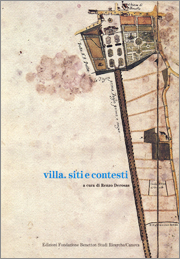
Villa. Siti e contesti
edited by Renzo Derosas
Fondazione Benetton Studi Ricerche-Canova
Treviso 2006
XXVI-270 pages
44 illustrations in colour and 30 black and white
cover price 33 euros
ISBN 88-8409-172-1
(Memorie, 11)
[Villa. Sites and contexts]
The volume contains contributions by James S. Ackerman, Filippo Benfante, Lucia Bulian, Giacinto Cecchetto, Salvatore Ciriacono, Franca Cosmai, Renzo Derosas, Mauro Pitteri, Franco Posocco, Massimo Rossi, Raffaello Vergani and Mauro Vigato.
During the 1500s the Veneto countryside rapidly became studded with splendid stately homes. This entirely new phenomenon was destined to lend a unique and unmistakeable character to both the material and the spiritual landscape of the region and profoundly to influence its cultural identity. Although the bibliography of the ville venete numbers over two thousand titles, scholarly experts still disagree on a number of issues and much remains to be analyzed and clarified. The most prominent aspects – the work of the principal architects, the most celebrated villas – have been the subject of detailed and wide-ranging study, but many of the fundamental features of this great historical process – the phases through which it developed, the areas that were most affected, the economic and social context of the villas, the environmental transformations, the various social groups that promoted them, the political implications of the presence of a new class of urban landowners, the ideology that inspired them and found expression in the villas – are questions about which much less is known than might be expected for such an intensely discussed subject. The essays in this volume are based on specific research carried out in recent years and on a selection of the materials presented and discussed during the seminar entitled Villa veneta. Siti e contesti (1400-1600). Casa dominicale, adiacenze funzionali, giardino, proprietà, paesaggio (TheVilla Veneta. Sites and contexts (1400-1600). Land-owner’s residence, functional appurtenances, garden, estate, landscape), led by Howard Burns and Domenico Luciani (organized by the International Andrea Palladio Centre for Architectural Studies and by the Fondazione Benetton Studi Ricerche); they offer a number of replies in this direction. The picture that emerges, with particular regard to the countryside around Treviso and to the crucial pre-Palladian phase, but also to aspects that fall outside these spatial and temporal limits, suggests new and in many ways unexpected viewpoints on the villa veneta of the sixteenth century, highlighting the complexity and the richness of the experience and its importance not only for the history of architecture but also for the economic, social and political history of the region.
Renzo Derosas is an Assistant Professor of Modern History in the Department of Historical Studies in the University of Venice Ca’ Foscari. He has published numerous essays in economic, social and demographic history and on the application of quantitative methods to historical research. His most recent work is Religion and the Decline of Fertility in the Western World, edited together with Frans van Poppel and published by Springer (2006).
Contents
Introduzione, a cura di Renzo Derosas, VII
I. Antichi e moderni: l’invenzione della tradizione
James S. Ackerman, Contesto della villa: il ruolo dei testi antichi, 3
II. Genesi e insediamento di casa dominicale in villa
Renzo Derosas, Le “case di villa” nel Trevigiano del primo Cinquecento.
Un problema di classificazione, 15
Filippo Benfante, Edilizia rurale nel distretto di Treviso alla fine del XV secolo. Alcuni esempi (1470-1500), 53
Mauro Pitteri, Indizi di ville nelle campagne trevigiane del XVI secolo, 63
Mauro Vigato, Preesistenze e indizi di ville nel territorio di Castelfranco Veneto nella prima metà del XVI secolo, 93
III. Architettura, giardino, paesaggio di villa
Giacinto Cecchetto, Ville e siti di ville del territorio storico di Castelfranco Veneto nelle fonti cartografiche e fiscali dei secoli XVI-XVIII, 125
Franca Cosmai, Le ville nella cartografia storica trevigiana, 155
Massimo Rossi, Ville e delizie: il controllo del territorio nella rappresentazione cartografica, 161
IV. Acqua, territorio, economia di villa
Salvatore Ciriacono, Ville venete, governo del territorio e uso dell’acqua a Venezia in età moderna, 187
Raffaello Vergani, Villa e acqua (1400-1600). Il caso della Brentella trevigiana, 199
Lucia Bulian, La villa come centro di credito rurale: il caso dei Barbaro a Maser, 211
V. La villa nella trasformazione contemporanea
Franco Posocco, Gli strumenti della tutela e della pianificazione, 223
Bibliografia citata, 239
Abbreviazioni archivistiche, 251
Elenco e referenze delle illustrazioni, 253
Indice dei nomi e dei luoghi, 255
